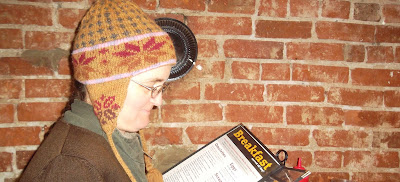Tuesday, December 27, 2016
‘The Autistic Gourmand,’ new blog
Eating is easily the most difficult sensory task for this woman on the autism spectrum. Risking unfamiliar tastes and textures, it takes time and considerable fortitude at times for me to get used to new foods.
The experience of eating — already fraught with sensory/tactile challenges — is further burdened by past experiences and prevalent social attitudes.
My new blog, The Autistic Gourmand, explores social “norms” and challenges related to consumption of food. Several writings originally posted here have been migrated or reprinted on the new subject-specific blog.
Saturday, December 24, 2016
Hat People’s ‘Leaf Corps’ hat
Walking around Medford, we got so many compliments for this “Leaf Corps” hat by Hat People that I got Jonathan for Christmas. (I assemble crowns and brims for Hat People’s “newsboy” hats, and that piecework financed Jonathan’s gift.)
Like its name suggests, the “Leaf Corps” hat has unique sylvan touches: a point to the brim suggestive of a leaf, leafy top-stitch embroidery, and a fabric tail at the top of the hat reminiscent of a plant’s stem.
Two ties wrap around and hang down the back, providing a patterned accent to the solid-color body of the hat.
Where they’re secured around the hat-band, the ties can fold down to keep the ears of the wearer warm; the dangling ends at back can serve the wearer as a scarf.
Jonathan has long admired Jim of Hat People’s “Leaf Corps” design. For Jonathan’s hat we chose the fabrics and expressed our preferences in detailing. We really appreciate Jim’s care in creating what turned out a masterpiece.
Monday, December 12, 2016
Why isn’t bullying an ‘Adverse Childhood Experience’?
As featured by PBS’ Next Avenue: a survey of Adverse Childhood Experiences (ACES) finds that effects of childhood trauma can persist into 50s and beyond.
As a survivor of bullying, I can corroborate that the effect lasts well into adulthood. But ACES focuses exclusively upon trauma committed against children by adults. Systemic ostracism and bullying by a child’s peers can also be devastating, but the questionnaire makes no mention of it.
As a survivor of bullying, I can corroborate that the effect lasts well into adulthood. But ACES focuses exclusively upon trauma committed against children by adults. Systemic ostracism and bullying by a child’s peers can also be devastating, but the questionnaire makes no mention of it.
Thursday, December 8, 2016
‘M in the Middle’ portrays girl’s experience of autism
M, a teenager recently diagnosed with autism, navigates school and social expectations while plagued by near-constant anxiety. She tries to shape her life to follow the “normal” life-event trajectory as defined by the greeting cards at her local Card Emporium and the idyllic life depiction of her television-drama idol, but can’t sustain the social “masks” she adopts to navigate friendship and dating.
M in the Middle (Jessica Kingsley Publishers, October 2016) offers a vivid portrayal of a teen girl on the autism spectrum. The book was written by the students of Limpsfield Grange School in England with creative-writing teacher Vicky Martin.
M in the Middle (Jessica Kingsley Publishers, October 2016) offers a vivid portrayal of a teen girl on the autism spectrum. The book was written by the students of Limpsfield Grange School in England with creative-writing teacher Vicky Martin.
Tuesday, December 6, 2016
‘Culture fit’: LinkedIn HR head offers caution
Appreciation to Pat Wadors, Head of HR at LinkedIn, for her cautionary take on using the term “culture fit” (LinkedIn Talent Solutions’ “Talent on Tap” video series and blog). I share Wadors’ concern that assessing for culture fit can lead to a “hire like me” mentality.
‘Fake news’: library scholars urge ‘metaliteracy’
 |
| Information via Internet. Image created with Bitstrips |
Subscribe to:
Comments (Atom)
Subject Classifications (Partial list, via Dewey Decimal System)
- 006.754-Social Media
- 020-Library and Information Science
- 020.7025-Library Education
- 020.92-Cynthia M. Parkhill (Biographical)
- 023.3-Library Workers
- 025.00285-Digital libraries
- 025.04-Internet Access
- 025.2-Libraries--Collection Development
- 025.213-Libraries--Censorship
- 025.3-Libraries--Cataloging
- 025.84-Books--Conservation and restoration
- 027.473-Public Libraries--Sonoma County CA
- 027.663-Libraries and people with disabilities
- 027.7-Academic Libraries--University of Central Missouri
- 027.8-School Libraries--Santa Rosa Charter School for the Arts
- 028.52-Children's Literature
- 028.535-Young Adult Literature
- 028.7-Information Literacy
- 158.2-Social Intelligence
- 302.34-Bullying
- 305.9085-Autism (People with Developmental Disabilities)
- 306.76-Sexual orientation and gender identity
- 371-Schools--Santa Rosa Charter School for the Arts
- 371-Schools--Santa Rosa City Schools
- 636.8-Cats
- 646.2-Sewing
- 658.812-Customer Service
- 659.2-Public Relations
- 686.22-Graphic Design
- 700-The Arts
- 746.43-Yarn bombing (Knitting and Crochet)
- 808.51-Public Speaking
- 809-Book Reviews



